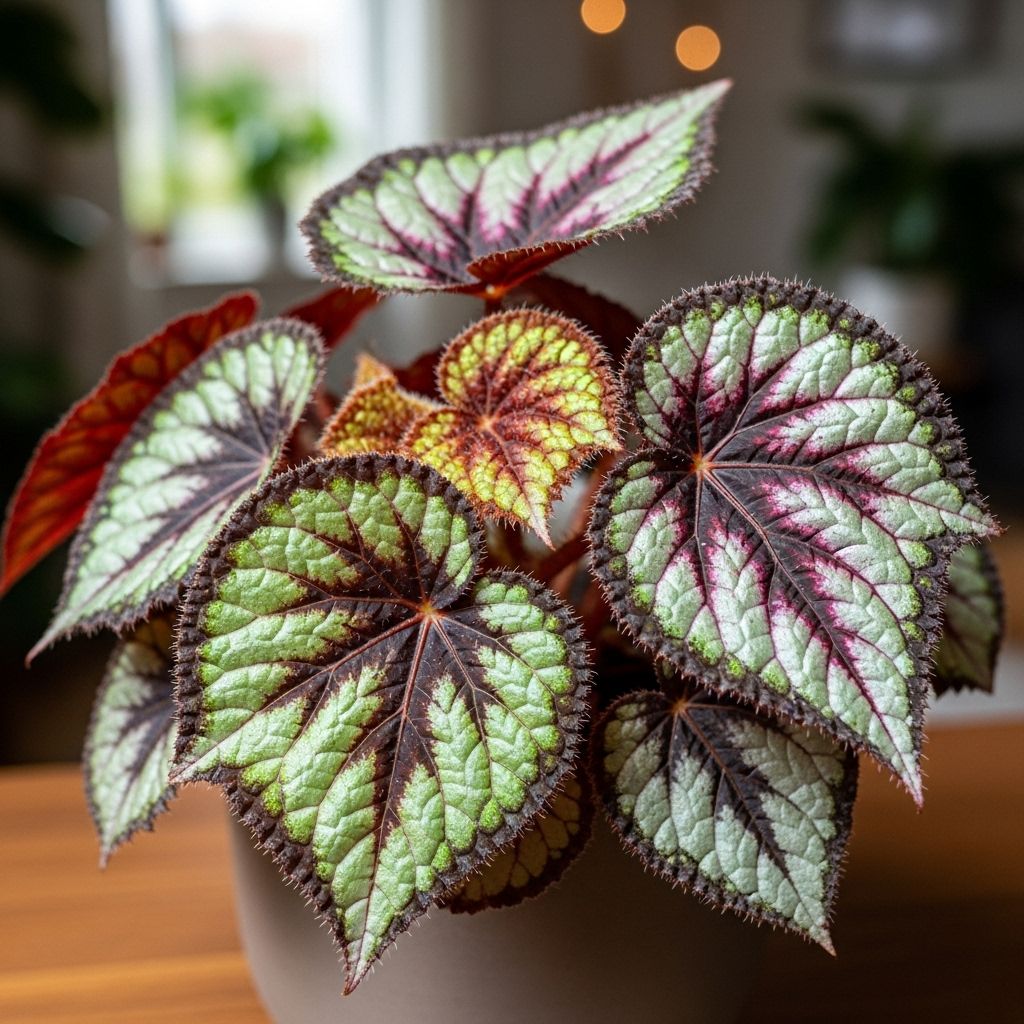Begonia Rex: Ultimate Guide to Growing and Caring for Rex Begonias Indoors
Small tweaks in care unlock the vibrant colors and intricate patterns of each leaf.

Image: HearthJunction Design Team
Begonia Rex: The Artful Foliage Houseplant
Begonia Rex, also known as the painted-leaf or king begonia, is prized for its dazzling, ornamental foliage. Its coloring ranges from metallic silver to deep purple, scarlet, green, and everything in between, making it a must-have for indoor gardeners and plant collectors alike. Though their flowers are modest, the true beauty of Rex begonias lies in their bold, variegated leaves, each displaying its own intricate and artistic pattern.
Table of Contents
- About Begonia Rex
- Light Requirements
- Watering and Humidity
- Soil, Potting, and Containers
- Temperature and Placement
- Feeding and Fertilization
- Pruning and Maintenance
- Propagation Methods
- Common Problems and Troubleshooting
- Notable Begonia Rex Varieties
- Frequently Asked Questions (FAQs)
About Begonia Rex
Begonia Rex-cultorum group comprises hybrids bred from several rhizomatous begonia species native to tropical and subtropical Asia. This lineage gives them stunningly diverse foliage, often highlighted with dramatic veins and metallic hues. Though originally grown outdoors in shaded environments, modern cultivars are exceptional indoor houseplants appreciated for their architectural form and vibrant color.
Key Features
- Colorful, textured leaves: spirals, spots, and metallic streaks
- Compact growth ideal for desktops, shelves, and plant arrangements
- Prefers humid, warm, shaded environments
- Flowers are modest and secondary to foliage interest
Light Requirements
Light is crucial for maintaining the vibrant colors and healthy growth that make Rex begonias so visually arresting. They thrive in environments that mimic the dappled light of a forest understory.
- Bright, indirect light is ideal—near north or east-facing windows, or set back from brighter south and west exposures.
- Direct sun can scorch and fade leaves; instead, filtered or diffused light preserves their variegation and prevents wilting.
- If insufficient light is provided, foliage may become leggy and lose coloration.
Tip: Sheer curtains or placement behind other plants can help soften strong sunlight.
Watering and Humidity
Watering
- Allow the top third (or top 1–2 inches) of soil to dry before the next watering.
- Overwatering can lead to root rot; always use pots with drainage holes.
- Reduce watering in winter, letting the surface of the compost dry out before dosing again.
- Avoid wetting the leaves and crown, which can invite fungal disease.
Humidity
- Requires high humidity—ideally 50% or above.
- If air is dry, leaf edges may brown or crispy; remedy by:
- Grouping with other plants,
- Placing on a pebble tray with water,
- Using a room humidifier,
- Misting cautiously (avoid leaves),
To ensure your Rex begonias thrive, understanding their blooming needs is just as crucial as soil selection. Discover our 11 proven tips for keeping your begonias blooming all season long. These practical insights will help you achieve that stunning display of flowers alongside beautiful foliage.
Tip: Never let the plant stand directly in water; high humidity around roots, not soggy soil, is key.
Soil, Potting, and Containers
Healthy roots are the foundation of thriving Begonia Rex plants, so the soil must be carefully chosen and containers well-suited.
- Use peat-based potting mix with pH between 5.7 and 6.4.
- Soil should be loose, aerated, and rich in organic matter—mix in compost or leaf mold for nutrition.
- Avoid compacted, heavy soils that can suffocate roots.
- Clay or ceramic pots help with moisture regulation; ensure drainage holes are present.
Recommended commercial mixes: Pro-Mix, Sunshine Mix, or Baccto Professional straight from the bag.
Temperature and Placement
- Warmth: Maintain a minimum of 13°C (55°F) for optimal growth—never let it dip below 10°C (50°F).
- Sudden cold drafts and fluctuating temperatures will stress the plant.
- Placement away from radiators, exterior doors, and air conditioning vents is best.
- Best grown indoors year-round in temperate regions, but can be enjoyed outdoors in shaded patios during warm summer months.
Feeding and Fertilization
- Feed every two weeks from May to September with a high-nitrogen fertilizer to support leaf development.
- During the plant’s rest period (autumn-winter), reduce or suspend feeding.
- Excess fertilizer can damage sensitive roots—dilute solutions to half strength if in doubt.
Pro tip: Occasional feeding with organic compost or worm castings delivers a gentle sustained boost.
Pruning and Maintenance
- Remove faded or damaged leaves regularly: this keeps the plant tidy, prevents disease, and encourages fresh growth.
- Pinch off weak or overly large stems to shape the plant and maintain compactness.
- Gently clean leaves using a soft brush or cloth to remove dust—avoid products that could clog pores.
Keep an eye out for rot or fungal patches in areas where moisture may be trapped (especially leaf bases).
Propagation Methods
Begonia Rex is one of the most generously propagating houseplants, for both beginners and enthusiasts.
Best Techniques
- Leaf cuttings: Detach a healthy leaf, make shallow cuts along prominent veins, and lay the leaf flat on moist potting mix. New plants will soon emerge from these cuts.
- Rhizome division: Divide the fleshy, creeping rhizomes of mature plants, ensuring each section has at least one leaf and a portion of the root.
- Softwood cuttings: Cut a tip with 1–2 nodes and root it in a moist, humid environment.
Place propagations in bright, indirect light and maintain high humidity (use a covered propagator or a plastic bag tent over the pot). Rooting can take several weeks, depending on warmth and moisture.
Common Problems and Troubleshooting
Despite their striking looks, Rex begonias can be temperamental if their ideal conditions are not met. Below is a guide to the most common challenges and solutions.
| Problem | Symptoms | Solution |
|---|---|---|
| Root Rot | Wilting, blackened base, foul odor | Check drainage, reduce watering, repot in fresh soil if needed |
| Leaf Burn | Brown/bleached leaf edges or tips | Move away from direct sun, provide diffuse light |
| Crispy Leaf Edges | Brown, brittle edges | Increase humidity, group with other plants, use pebble tray |
| Powdery Mildew | White, powdery spots on foliage | Improve air circulation, avoid wetting leaves, remove affected foliage |
| Pest Infestation (mealybugs, spider mites) | Sticky residue, visible insects, webbing | Treat promptly with insecticidal soap or neem oil |
| Leaf Drop | Leaves fall prematurely | Check for overwatering, cold drafts, or low light |
Notable Begonia Rex Varieties
- Begonia rex ‘Hugh McLauchlan’: Striking purple-red leaves with deep veining and metallic overlay.
- Begonia rex ‘Escargot’: Spiraled leaves with silver and green whorls reminiscent of snail shells.
- Begonia rex ‘Fireworks’: Dramatic foliage in violet, silver, and green with a central jet-black starburst.
- Begonia rex ‘Merry Christmas’: Festive green leaves dashed with silver and red highlights.
Modern breeding continues to deliver even more vivid coloration and leaf complexity—collectors often seek out new cultivars from specialty growers and botanical gardens.
Frequently Asked Questions (FAQs)
Q: Why are the leaves of my Begonia Rex crispy at the edges?
A: Crispy leaf edges almost always indicate low humidity. Move your plant to a more humid room, group it with others, or use a humidity tray to maintain a 50% or higher humidity level.
Q: How often should I water my Rex Begonia?
A: Water only when the top 1–2 inches of soil feel dry. Reduce frequency during winter, and always remember that overwatering is more harmful than minor underwatering.
Q: Can I grow Begonia Rex outdoors?
A: In warm climates above 13°C (55°F), they can be grown outdoors in shaded beds or containers. They must be protected from direct sun, extreme temperature drops, and must not be left outside during frosty nights.
Q: Is Begonia Rex safe for pets?
A: Be aware: like many begonias, Rex cultivars may be mildly toxic to pets if ingested, causing oral irritation or stomach upset. Place them out of reach of nibbling animals.
Q: Why does my Begonia Rex have faded leaves?
A: Fading or washed-out color is usually a sign of either too much direct sunlight or insufficient feeding. Move the plant to a spot with filtered light, and consider regular fertilization during the growing season.
Final Care Tips
- Rotate your plant regularly to encourage symmetrical growth.
- Keep an eye out for early signs of pests or disease, and act quickly.
- Do not repot unnecessarily—Rex Begonias prefer to be slightly root-bound.
- Enjoy their ever-changing, living artwork and experiment with arrangements for best display.
Inspiration: Styling with Begonia Rex
Show off your Begonia Rex in pottery that complements its dazzling leaves—think matte whites, bold ceramics, or vintage finds. Place on plant stands in well-lit corners, combine with other shade-loving species like ferns and calatheas, or set them on trays to build miniature indoor jungles. Their unique look makes them perfect as gifts or centerpieces for plant enthusiasts seeking dramatic texture and color indoors.
References
Read full bio of Shinta












